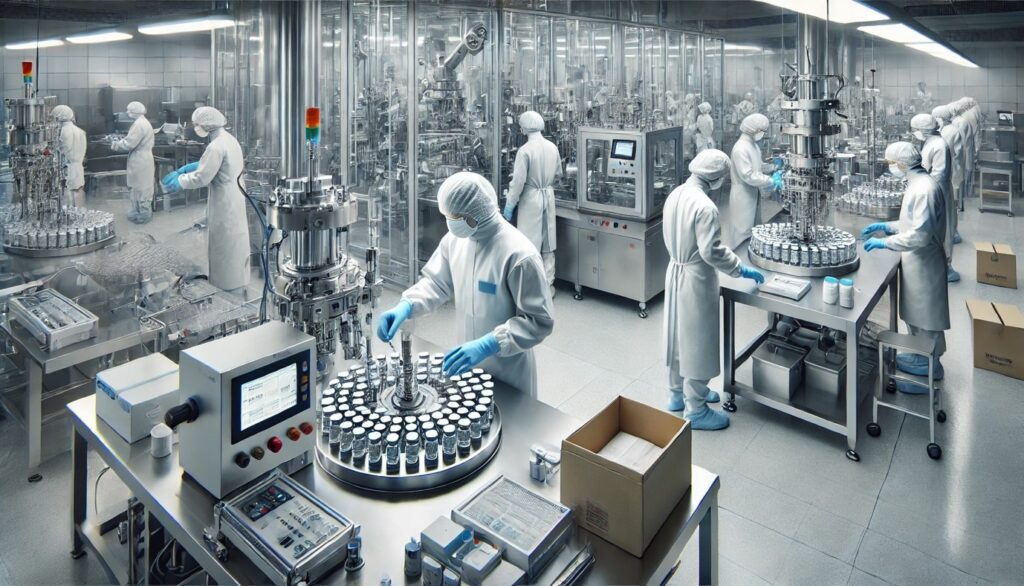
Image Credits: DALL.E
Fill-finish and lyophilization are essential processes in the pharmaceutical industry, particularly for protecting sensitive drug formulations.
Fill-finish occurs before lyophilization during which the drug formulation is precisely filled into vials or other primary packaging to ensure dosage accuracy and prevent contamination. Following the fill-finish process, lyophilization significantly improves product stability by removing moisture, prolonging shelf life, and protecting sensitive formulations against degradation.
A majority of marketed biopharmaceuticals—such as monoclonal antibodies, vaccines, therapeutic proteins, and plasma products—require fill-finish and lyophilization steps to ensure their effectiveness and longevity.
Understanding the Lyophilization Process in Context of Fill-Finish
Following the fill-finish process, the lyophilization process is separated into three main steps, each of which is critical for getting the desired product attributes:
1. Freezing Stage
After the fill-finish operation, the product goes through the freezing stage of lyophilization. This phase’s effectiveness is strongly dependent on the precision attained during fill-finish, as any deviations in the filled volume can affect freezing consistency and the overall cycle.
By carefully regulating freezing rates and integrating cryoprotectants, the formulation’s structural integrity is preserved.
2. Primary Drying Stage
At this point, sublimation eliminates frozen water from the product. Precise fill-finish ensures that the vials are uniform, allowing for even drying across batches.
This stage requires precise temperature and pressure control, therefore the fill-finish process must be tightly controlled to prevent variability, which can compromise product quality.
3. Secondary Drying Stage
The final stage removes residual moisture, which is needed to ensure the product’s intended shelf life.
The fill-finish procedure must be in sync with the lyophilization parameters to ensure the product remains stable over time.
Key Considerations for Successful Lyophilization with Fill-Finish
1. Formulation and Finish Design
It is critical to select the right formulation and achieve precision during the fill-finish process. Properly designed excipients and cryoprotectants improve stability during the fill-finish and lyophilization processes, preventing degradation.
A well-structured fill-finish procedure guarantees that the product retains its required characteristics throughout the lyophilization cycle.
2. Thermal Characterization and Fill-Finish Impact
Optimising the lyophilization cycle requires understanding the formulation’s thermal characteristics after fill-finish.
Techniques like as Modulated Differential Scanning Calorimetry (mDSC) help in identifying crucial temperatures that affect the drying process, which are also influenced by fill-finish uniformity.
3. Optimizing the Fill-Finish and Lyophilisation Cycles
Optimising the fill-finish operation provides the correct fill volume, which has a direct impact on the success of the next lyophilization cycle.
Pharmaceutical manufacturers can maintain critical quality attributes (CQAs) by systematically identifying ideal fill volumes, freezing rates, shelf temperatures, and vacuum pressures, resulting in consistent and reliable results.
4. Validation and Regulatory Adherence
Thorough validation of both the fill-finish and lyophilization steps is necessary to ensure that the processes consistently produce products that fulfil regulatory criteria. Proper validation helps to ensure adherence to industry guidelines, lowering contamination risks and improving the end product’s safety.
The Interconnected Role of Fill-Finish and Formulation Development
Formulation development and fill-finish precision are closely interconnected, impacting the overall success and efficiency of the lyophilization process.
Key aspects of this collaboration include selecting the appropriate excipients, cryoprotectants, and stabilizers, ensuring compatibility between the drug and its packaging, and maintaining consistency throughout the process.
Summing Up
Successfully managing the fill-finish and lyophilization processes for sensitive drug formulations requires high levels of expertise and precision.
As the pharma industry’s trusted partner since the last three decades, Grover Holdings is elated to bring to India ATS Scientific I-dositecno’s wide range of GMP-compliant aseptic fill-finish solutions that are specially optimised for small batches of up to 200 upm.
From vial washers, depyrogenation tunnels, and filling & stoppering equipment to cappers and lyophilizers & loading/unloading systems, ATS’s fill-finish solutions can be easily configured to create an end-to-end fill-finish manufacturing line or be customised as individual modules to suit any use case.
To learn more about ATS Scientific I-dositecno’s fill-finish solutions, please get in touch with us at [email protected] or +91 98211 11623.

